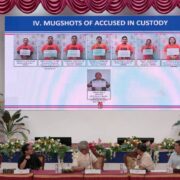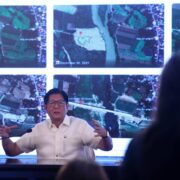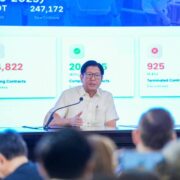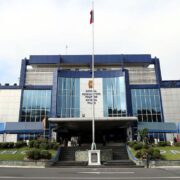ENDING 2023 WITH A CARBON-NEUTRAL BANG
In light of everything that’s happening in our global climate and environment, the very idea of motorsports has somewhat turned into a guilty pleasure. Sure, everybody loves the excitement, the competition, the noise of car races. But at what cost to an environment already saturated with climate change-inducing greenhouse gases?
As it stands, human activities, particularly the transport industry, have had a big hand in accelerating global climate change to the point where adverse effects on humans and other living creatures would be considered irreversible. Climate scientists have been calling for drastic reductions in emissions of internal combustion engines.
And yet, even as the hot breath of climate change breathes down our necks, we still need to fulfill this need for speed. We need to feel the thrill of the chase. We have to race against one another, and even dare to race against time itself. Those ICE-powered speed demons provide us the highest of highs. But then again, when the smoke clears, at what cost to our own climate future—yes, even to our own survival—did we get our kicks?
The world’s most prolific maker and seller of ICE cars, however, is racing to find a middle ground. In the upcoming Idemitsu Super Endurance Southeast Asia Trophy 2023 in Thailand—particularly in the 10-hour endurance race to be held on Dec. 22 and 23 at the Chang International Circuit—Toyota Motor Corp will be fielding in three vehicles that would minimize their carbon footprints during the race. These would be a GR86 CNF (carbon-neutral fuel) concept, a GR Corolla H2 concept (hydrogen-powered), and a Prius CNF-HEV GR concept—marking the first time that Toyota will field a production Prius hybrid electric vehicle in a race.
No less than Morizo (aka Akio Toyoda, TMC chair and designated Master Driver) will lead the Toyota racing team. His son Daisuke Toyoda is also slated to race. The other drivers are (as of presstime), Yasuhiro Ogura, Kachorn Chiaravanont, Masahiro Sasaki, Tatsuya Kataoka, Hiroaki Ishiura, Kazuya Oshima, Naoya Gamo, Kenta Yamashita, Hibiki Taira, and Keizo Kato. Providing support to these racers would be a contingent of engineers from Toyota.
It’s no surprise that Akio Toyoda, a hardcore petrolhead and racing fanatic, has chosen Thailand to end Toyota’s eventful and pivotal year. The man simply loves this “Land of Smiles.” He was quoted last year by the Financial Times as saying, “I have always considered Thailand my ‘home away from home.’ If I didn’t have to live in Japan for my job … I’d live here!” He would have no problem finding an office here, too, as Toyota maintains a key manufacturing hub in the country.
Significant reduction in CO2 emissions
What is carbon-neutral fuel or CNF, anyway? Toyoda, in an April 2021 press conference, explained that CNFs such as those using hydrogen and biofuels, “when combined with the high-efficiency engine and electric motor technologies accumulated in the Japanese automotive industry, can significantly reduce CO2 emissions.”
CNFs play a key role in Toyota’s multi-pathway approach to new energy vehicles. The world’s leading carmaker has stressed that it is also working on developing innovative battery EV technologies, as well as the establishment of hydrogen as a viable and practical fuel source.
This multi-pathway approach, if successful, would not only make existing infrastructure continue to be usable, “but all vehicles, including used vehicles, will be able to reduce their CO2 emissions,” said Akio.
“And this concept can be applied to a variety of industries other than automobiles, such as ships and airplanes. If carbon neutrality of transportation, especially of ships, gets advanced, it will lead to making greener Japan’s business model, which is largely driven by imports and exports. Our goal is to be carbon neutral, and there should be more than one path to that goal,” Akio stressed.
The industry ‘pacemaker’
Akio went on to explain: “We have carbon-neutral fuel technologies, engine combustion technologies, electrification technologies such as electric motors and batteries, and composite technologies that combine these technologies—I believe that there is a path for Japan to choose in which we can fully take advantage of our strengths.
“Carbon neutrality cannot be achieved without reducing CO2 emissions throughout the entire process: Making, transporting, using, and disposing of. In other words, it is essential for all people and all industries to align and work together. And that is where we believe we need a ‘pacemaker.’ Since the automotive industry is comprehensive and deeply engaged in many other industries such as energy and materials, we believe that we can play a key role as a pacemaker for the overall industry.”
In development for 5 decades
During my interview with Toyota engineers in Tokyo two months ago, it was revealed that Toyota had been working on vehicle electrification for carbon reduction since the ‘70s. From 1990 onwards, Toyota has had an EV development division.
Pras Ganesh, EVP of Toyota Daihatsu Engineering and Manufacturing, told this author: “We’ve been studying these technologies before the words ‘carbon neutrality’ were even discussed, and even before it caught the attention of external stakeholders. In that context, of course, we must think about how we find the solution for carbon reduction that works for everyone. We want to make sure that everyone is able to transition.”
Toyota Gazoo Racing (GR) has been refining its Racing Hybrid technology through its participation in the World Endurance Championship (WEC). This time, Toyota will introduce technology suitable for racing to the Prius to refine HEV technology that combines the fun of driving and fuel efficiency.
In addition, Toyota will take on the challenge of expanding possibilities for the future together with its partner Kachorn Chiaravanont, who will compete as a Prius driver. Chiaravanont is a member of the executive committee of Charoen Pokphand Group (CP), a partner working to achieve a carbon-neutral society in Thailand, and president of True Leasing Co Ltd.
Produce, transport, use hydrogen
In the Thailand 10-hour Endurance Race, biogas generated from the chicken manure from CP’s poultry farm and food waste from Toyota Daihatsu Engineering & Manufacturing Co (TDEM), a Toyota site, will be used as part of the fuel for the hydrogen-powered Corolla.
In addition, an FC drone used for demonstration experiments in collaboration with CP will be unveiled for the first time at the event to introduce efforts in producing, transporting, and using hydrogen that is currently being promoted by Toyota and its partners in Thailand. In doing so, Toyota will expand the scope of its efforts to build a hydrogen utilization model to the rest of Asia, starting with Thailand.
“There is a carbon neutral path for us as car lovers. We don’t want to leave any car lovers behind,” Toyoda has said. And I’m crossing my fingers that this multi-pathway effort is enough to out-race the devastating impact of climate change.















